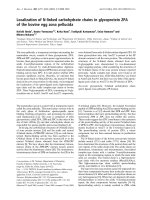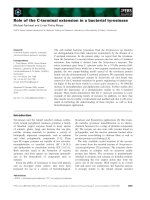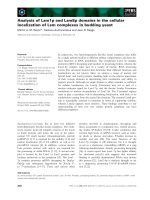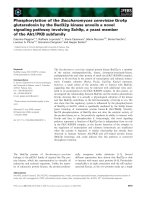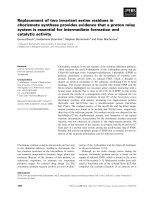Báo cáo khoa học: Replacement of two invariant serine residues in chorismate synthase provides evidence that a proton relay system is essential for intermediate formation and catalytic activity docx
Bạn đang xem bản rút gọn của tài liệu. Xem và tải ngay bản đầy đủ của tài liệu tại đây (380.9 KB, 10 trang )
Replacement of two invariant serine residues in
chorismate synthase provides evidence that a proton relay
system is essential for intermediate formation and
catalytic activity
Gernot Rauch
1
, Heidemarie Ehammer
1
, Stephen Bornemann
2
and Peter Macheroux
1
1 Institute of Biochemistry, Graz University of Technology, Austria
2 Department of Biological Chemistry, John Innes Centre, Norwich, UK
Chorismate synthase catalyzes the seventh and last step
in the shikimate pathway, leading to chorismate, the
last common precursor in the biosynthesis of numer-
ous aromatic compounds in bacteria, fungi, plants and
protozoa. Because of the absence of this pathway in
eukaryotic organisms, its enzymes are interesting
potential targets for rational drug design [1]. The
chorismate synthase reaction involves an anti-1,4-elimi-
nation of the 3-phosphate and the C(6proR) hydrogen,
as shown in Scheme 1 [2,3].
Although no net redox change occurs during the
reaction, chorismate synthase activity is based on the
supply of reduced FMN, which is bound in the active
site of the enzyme [3–5]. Mechanistic studies have indi-
cated a functional role of the reduced flavin [6,7] that
comprises the transient donation of an electron (or a
Keywords
enzyme mechanism elimination; flavin;
shikimate pathway; site-directed
mutagenesis
Correspondence
P. Macheroux, Institute of Biochemistry,
Graz University of Technology,
Petersgasse 12 ⁄ II, A-8010 Graz, Austria
Fax: +43-316-873 6952
Tel: +43-316-8736450
E-mail:
(Received 6 December 2007, revised 15
January 2008, accepted 21 January 2008)
doi:10.1111/j.1742-4658.2008.06305.x
Chorismate synthase is the last enzyme of the common shikimate pathway,
which catalyzes the anti-1,4-elimination of the 3-phosphate group and the
C-(6proR) hydrogen from 5-enolpyruvylshikimate 3-phosphate (EPSP) to
generate chorismate, a precursor for the biosynthesis of aromatic com-
pounds. Enzyme activity relies on reduced FMN, which is thought to
donate an electron transiently to the substrate, facilitating C(3)–O bond
breakage. The crystal structure of the enzyme with bound EPSP and the
flavin cofactor highlighted two invariant serine residues interacting with a
bound water molecule that is close to the C(3)–O of EPSP. In this article
we present the results of a mutagenesis study where we replaced the two
invariant serine residues at positions 16 and 127 of the Neurospora crassa
chorismate synthase with alanine, producing two single-mutant proteins
(Ser16Ala and Ser127Ala) and a double-mutant protein (Ser16Ala-
Ser127Ala). The residual activity of the Ser127Ala and Ser16Ala single-
mutant proteins was found to be six-fold and 70-fold lower, respectively,
than that of the wild-type protein. No residual activity was detected for the
Ser16AlaSer127Ala double-mutant protein, and formation of the typical
transient intermediate, characteristic for the chorismate synthase-catalysed
reaction, was not observed, in contrast to the single-mutant proteins. On
the basis of the structure of the enzyme, we propose that Ser16 and Ser127
form part of a proton relay system among the isoalloxazine ring of FMN,
histidine 106 and the phosphate group of EPSP that is essential for the for-
mation of the transient intermediate and for substrate turnover.
Abbreviations
EPSP, 5-enolpyruvylshikimate 3-phosphate; NcCS, Neurospora crassa chorismate synthase; wat 1 wat 2 and wat 3, water molecules in
chorismate synthase.
1464 FEBS Journal 275 (2008) 1464–1473 ª 2008 The Authors Journal compilation ª 2008 FEBS
charge transfer) to the substrate, prompting cleavage
of the C–O bond and thereby facilitating phosphate
cleavage. At the end of the catalytic cycle an electron
(or negative charge) is redistributed to maintain the
reduced form of the flavin cofactor [8–11].
The theoretical and experimental evidence for such a
role of the reduced FMN eagerly demanded structural
information of the protein. Eventually, the structure
determination of Streptococcus pneumoniae chorismate
synthase in the presence of oxidized FMN and 5-enol-
pyruvylshikimate 3-phosphate (EPSP) provided the first
insight into the binding and relative orientation of the
cofactor and of the substrate in the active site of the
enzyme [10]. Based on this structure we were able to
initiate a structure-based mutagenesis study to test
mechanistic proposals. In our first study we demon-
strated that the invariant histidine residues (His17 and
His106) function as general acids in the active site, with
His106 protonating the N(1)–C(2)=O locus of reduced
flavin whereas His17 appears to be involved in the pro-
tonation of the leaving phosphate group [12]. The next
target was Asp367, which is in the direct vicinity of the
N(5) atom of the isoalloxazine ring system and a likely
candidate in a position for the abstraction of hydrogen
from the substrate. Single-mutant proteins in which
Asp367 has been replaced with alanine or asparagine
exhibit a 300- and 600-fold lower activity, respectively,
emphasizing the important role of the Asp367 residue
as an active-site base. These results provide strong evi-
dence that acid–base catalysis is of great importance in
the chorismate synthase reaction [13].
Multiple sequence alignments of chorismate synthas-
es from bacterial, fungal, plant and protozoan origin,
of the crystal structure of the enzyme with bound
EPSP and of the flavin cofactor, revealed two invariant
serine residues – Ser16 and Ser127 – interacting with
several bound water molecules. As shown in Fig. 1,
one water molecule (wat 1) is held by both serine side
chains (in the reported structure of S. pneumoniae
chorismate synthase, these positions are designated as
Ser9 and Ser132, [10]) close to the C(3)–oxygen, while
another water molecule (wat 2) is bound between a
third water molecule (wat 3) and a C1 carboxyl oxygen
of the substrate that is also hydrogen bonded to
His106. The third water molecule bridges the first two
water molecules. There are both open (Fig. 1A) and
closed (Fig. 1B) active-site structures that reveal a
tightening up of the site in the latter together with a
movement of the His106 side chain away from the fla-
vin and towards the substrate [its ring nitrogen atom
that participates in hydrogen bonding moves 1.3 A
˚
away from the C(2=O) oxygen of the flavin ring sys-
tem and 1.2 A
˚
closer to the oxygen atom of the car-
boxyl group of EPSP].
In order to probe the pertinent role of the Ser16 and
Ser127 residues, we generated two single-mutant pro-
teins where the two serine residues were replaced with
alanine, producing two single-mutant proteins (Ser16-
Ala and Ser127Ala) and a double-mutant protein
(Ser16AlaSer127Ala). In this article, we report that
the replacement of both invariant serine residues
(Ser16AlaSer127Ala double-mutant protein) in the
active site of chorismate synthase caused a substantial
decrease in activity beyond the detection limit of our
assay. In contrast to the single-mutant proteins
(Ser16Ala and Ser127Ala) the Ser16AlaSer127Ala dou-
ble-mutant protein was not able to form the typical
transient intermediate. Based on our results, we pro-
pose that Ser16 and Ser127 establish a proton relay
system among the isoalloxazine ring, His106 and the
EPSP molecule that delivers protons via water mole-
cules either to His106, protonating the flavin at N(1)
position, or to the C(3)–oxygen of the phosphate-
leaving group to facilitate C–O bond breakage.
Results
Expression and purification of the Ser16Ala and
Ser127Ala single-mutant proteins and of the
Ser16AlaSer127Ala double-mutant protein
The mutant proteins were heterologously expressed
in Escherichia coli, strain BL21(DE3)RP at expression
levels similar to those of the wild-type protein. The
two-step chromatographic procedure developed for
the purification of wild-type enzyme yielded similar
amounts of the mutant proteins (3 mg of protein per
gram of wet cell paste) [14]. Because of the weak bind-
ing of (oxidized) FMN, all mutant proteins were iso-
lated in their apo-form. The apparent stability of all
three mutant proteins was comparable to that of the
wild-type enzyme.
Binding of oxidized FMN to the mutant proteins
To characterize the serine mutant proteins in further
detail, binding of the oxidized FMN cofactor to the
isolated apoproteins was investigated by UV ⁄ visible
Scheme 1. Reaction catalyzed by chorismate synthase.
G. Rauch et al. Proton relay system in chorismate synthase
FEBS Journal 275 (2008) 1464–1473 ª 2008 The Authors Journal compilation ª 2008 FEBS 1465
difference absorbance spectroscopy (Fig. 2). The spec-
tral changes observed upon binding of oxidized FMN
to the serine mutant proteins were identical to those
seen with the wild-type enzyme [14]. The dissociation
constant for the Ser127Ala mutant protein (Table 1)
was similar to that of the wild-type enzyme, whereas
the replacement of Ser16 with alanine resulted in a
slight increase of the dissociation constant (inset of
Fig. 2 and Table 1). Similarly, the Ser16AlaSer127Ala
double-mutant protein showed slightly weaker binding
of the cofactor (Table 1). Note that for the wild-type
E. coli protein, its dissociation constant for flavin
decreases by three orders of magnitude when the flavin
becomes reduced [15].
Binding of EPSP to the mutant proteins in the
presence of oxidized FMN
Because the replaced serine residues are located in the
direct vicinity of EPSP (Fig. 1A) it is important to
ensure that binding of EPSP to the active site is not
hampered. Binding of EPSP to the Ser16Ala, Ser127-
Ala and Ser16AlaSer127Ala mutant proteins in the
presence of oxidized FMN was monitored by UV ⁄ visi-
ble spectroscopy. The spectral changes observed upon
the binding of EPSP were exploited to determine the
dissociation constants for EPSP. The spectral perturba-
tions on EPSP binding, and the calculated dissociation
constants for the Ser16Ala and the Ser127Ala single-
mutant proteins, were found to be similar to those of
the wild-type enzyme (Table 1). As shown in Fig. 3,
the spectral changes observed when EPSP bound
to the double-mutant protein were comparable to
those observed with the wild-type protein, whereas the
calculated dissociation constant was 10-fold higher
than observed with the wild-type enzyme [14]. Note
that the K
m
for EPSP was 2.7 lm with the wild-type
enzyme [16] and therefore one order of magnitude
lower than the dissociation constant determined in the
presence of oxidized flavin.
B
A
Fig. 1. Ser16 and Ser127 residues acting in
a proton relay system among His106, FMN
and EPSP via a water molecule in the
chorismate synthase active site. (A) Stereo-
representation of the active site in the open
form, where His106 is in a position close to
C(2)=O of the flavin. (B) Stereorepresenta-
tion of the chorismate synthase active site
in the closed form, where His106 makes
contact with the O12 of EPSP. The carbon
atoms of Ser16, Ser127, His106, FMN and
EPSP are colored gray. The red spheres rep-
resent water positions. Hydrogen bonds are
shown as dashed lines. wat 1, wat 2,
wat 3, are different water molecules.
Proton relay system in chorismate synthase G. Rauch et al.
1466 FEBS Journal 275 (2008) 1464–1473 ª 2008 The Authors Journal compilation ª 2008 FEBS
Fig. 2. Binding of oxidized FMN to the
Ser16Ala mutant protein. The plot shows
the result of titration of the Ser16Ala mutant
protein (23 l
M) with oxidized FMN in 50 mM
Mops buffer, pH 7.5. Arrows indicate the
direction of the spectral changes occurring
upon titration with FMN. Difference absor-
bance spectra at 0, 9.8, 14.6, 22.3, 41.2 and
78.1 l
M oxidized FMN are shown. The inset
shows the spectral changes at 379 nm as a
function of FMN concentration, revealing a
dissociation constant (K
d
)of60lM.
Table 1. Dissociation constant (K
d
) values for FMN and EPSP.
Ligand
K
d
(lM)
Method
Wild-type
NcCS
NcCS
Ser16Ala
NcCS
Ser127Ala
NcCS Ser16Ala
Ser127Ala
FMN 41 ± 5
a
60 ± 7
a
40 ± 9
a
56
b
UV ⁄ visible difference spectroscopy
EPSP
(in the presence of FMN)
17
b
22
b
15
b
155
b
UV ⁄ visible spectroscopy
a
Average of three independent measurements.
b
Average of two independent measurements.
Fig. 3. Binding of EPSP to the Ser16Ala-
Ser127Ala double-mutant protein in the
presence of oxidized FMN. The course of a
titration of the Ser16AlaSer127Ala double-
mutant protein with EPSP in 50 m
M Mops
buffer, pH 7.5 is shown. UV-visible absor-
bance spectra of the Ser16AlaSer127Ala
double-mutant protein (30 l
M) and FMN
(25 l
M) were recorded at various EPSP con-
centrations. The spectra shown are at the
following EPSP concentrations: 0, 5.7, 9.9,
21, 42.4, 69.4, 109.3, 148.6, 200 and
250.3 l
M. The arrows indicate the direction
of the absorbance changes. The inset
shows the spectral changes at 397 nm as a
function of EPSP concentration, revealing a
dissociation constant (K
d
) of 155 lM.
G. Rauch et al. Proton relay system in chorismate synthase
FEBS Journal 275 (2008) 1464–1473 ª 2008 The Authors Journal compilation ª 2008 FEBS 1467
Intrinsic FMN:NADPH oxidoreductase activity
of the mutant proteins
Chorismate synthase from Neurospora crassa has an
intrinsic NADPH:FMN oxidoreductase activity that
enables the enzyme to generate the reduced FMN
cofactor (bifunctionality). The structural basis of this
‘secondary’ catalytic activity is presently not known
[4,17]. We investigated the effect of the mutations
on the NADPH:FMN oxidoreductase activity of the
mutant proteins. From the obtained hyperbolic depen-
dency, Michaelis–Menten parameters of 14, 14, 4 and
7 lm were calculated for the wild-type protein and for
the Ser16Ala, Ser127Ala and Ser16AlaSer127Ala
mutant proteins, respectively. These results demon-
strated that none of the amino acid replacements
significantly affected the utilization of NADPH as a
source of reducing equivalents for activation of the
cofactor to its reduced form.
Chorismate synthase activity of the serine
mutant proteins
In order to investigate the influence of the amino acid
replacements on the catalytic activity of chorismate syn-
thase, we measured the activity of the mutant proteins.
An activity assay under aerobic conditions using
NADPH as a source of reducing equivalents (15) indi-
cated that the amino acid replacements have a large
effect on the activity of the mutant proteins in com-
parison to the wild-type enzyme. Under these condi-
tions, we measured a residual activity of 2% for the
Ser16Ala single-mutant protein and of 12% for the
Ser127Ala single-mutant protein compared with that
of the wild-type enzyme. However, we were not able
to determine any activity for the Ser16AlaSer127Ala
double-mutant protein.
The precise residual activity of the mutant proteins
was then measured using the stopped-flow instrument
under anoxic conditions where we used photoreduction
to generate the reduced flavin cofactor. In the absence
of oxygen, the rate of chorismate formation was six- and
70-fold lower for the Ser127Ala and Ser16Ala mutant
proteins, respectively, than for the wild-type enzyme, as
shown in Table 2. The residual activity of the Ser16Ala-
Ser127Ala double-mutant protein was below the detec-
tion limit of the instrument (Table 2). Therefore, we
performed the same activity assay with a 10-fold higher
concentration of the Ser16AlaSer127Ala mutant protein
(125 lm instead of 12.5 lm) but again we were unable
to detect chorismate formation.
The chorismate synthase-catalysed reaction is char-
acterized by the occurrence of a transient species
with an absorbance maximum at around 390 nm
[18]. This species is known to form after the sub-
strate binds to the reduced FMN–enzyme binary
complex [9] but before EPSP undergoes transforma-
tion to the product [18,19]. This species is formed
very rapidly (within a few milliseconds) and dis-
appears when all substrate has been consumed. The
formation of the intermediate by the two serine
single-mutant proteins was almost complete within
the dead time of the instrument and indistinguishable
from that of the wild-type in single-turnover experi-
ments (Fig. 4). For the Ser16AlaSer127Ala double-
mutant protein we were not able to detect the
intermediate. This demonstrates that the Ser16Ala-
Ser127Ala double-mutant protein, in contrast to the
single-mutant proteins (Ser16Ala and Ser127Ala) is
not capable of forming the flavin-derived intermedi-
ate. The decay rate of the intermediate in a single-
turnover experiment in general reflects the rate of
substrate turnover. In the case of the Ser127Ala and
Ser16Ala single-mutant proteins, the decay of the
transient species was eight- and 140-fold slower,
respectively, than that of the wild-type enzyme, in
good agreement with the slower rate of substrate
turnover (Table 3).
In contrast to the wild-type protein, the spectra of
the transient flavin species of the two single serine
mutant proteins (Ser16Ala and Ser127Ala) have
slightly different spectral properties. As shown in
Fig. 5, both single-mutant proteins show, in addition
to the peak at 390 nm, a broad shoulder in the range
of 430–480 nm. Thus, both serine single-mutant pro-
teins (Ser16Ala and Ser127Ala) affect the spectral
characteristics of the transient flavin intermediate. Sim-
ilar spectral changes were observed during turnover
with the substrate analogue (6S)-6-fluoro-EPSP [20].
Table 2. Chorismate synthase activity of the serine mutant pro-
teins (Ser16Ala, Ser127Ala and Ser16AlaSer127Ala) in comparison
with the activity of the wild-type enzyme. The formation of choris-
mate was monitored at 275 nm using stopped-flow spectrophoto-
metry under anaerobic conditions.
Chorismate
synthase
activity
NcCS
Wild-type
NcCS
Ser16Ala
NcCS
Ser127Ala
NcCS
Ser16Ala
Ser127Ala
k
catÆ
s
)1
0.87 0.012 0.14 Below
detection
limit
%
a
100 1.38 16.1
a
Chorismate synthase activity compared with wild-type NcCS
activity.
Proton relay system in chorismate synthase G. Rauch et al.
1468 FEBS Journal 275 (2008) 1464–1473 ª 2008 The Authors Journal compilation ª 2008 FEBS
Thus, small perturbations in the substrate and its
immediate vicinity have similar effects on the flavin
environment.
Discussion
The 1,4-elimination of the 3-phosphate group and
the C-(6proR) hydrogen from EPSP to chorismate by
chorismate synthase is still one of the most challeng-
ing flavin-dependent reactions. The activity of the
chorismate synthase-catalysed reaction is dependent
on the supply of reduced FMN, which is bound in
the active site of the enzyme [3–5,10]. Several kinetic
and mechanistic studies have accumulated substantial
evidence for a radical mechanism in which the
enzyme-bound reduced FMN facilitates C–O bond
cleavage by transient electron donation (or negative
charge transfer) to the substrate [6,7]. At the end of
the catalytic cycle, an electron (or negative charge) is
redistributed to maintain the reduced form of the
Fig. 4. Formation of a transient flavin intermediate during substrate
turnover with wild-type enzyme (A), the Ser127Ala mutant protein
(B) and the Ser16Ala mutant protein (C). The absorbance changes
were observed at 390 nm as a function of time in single-turnover
experiments under anoxic conditions using stopped-flow spectro-
photometry. The formation of the intermediate was obscured by
the dead time of the instrument but its exponential decay is clearly
visible.
Table 3. Decay rates of the transient flavin intermediate. The
decay rates for the wild-type NcCS and for the two single-mutant
proteins were obtained using stopped-flow spectrophotometry
under anaerobic conditions (single turnover). The absorbance
changes were observed at 390 nm as a function of time.
NcCS
Wild-type
NcCS
Ser16Ala
NcCS
Ser127Ala
NcCS Ser16Ala
Ser127Ala
Decay
rate (s
)1
)
2.4 0.017 0.29 No intermediate
detected
%
a
100 0.7 12
a
Chorismate synthase decay rates compared with the wild-type
NcCS decay rate.
Fig. 5. Observation of the flavin intermediate in the chorismate
synthase reaction. Comparison of the difference absorbance spec-
tra formed during the reaction with wild-type enzyme (solid line),
the Ser16Ala mutant protein (dotted line) and the Ser127Ala mutant
protein (dashed line). The wild-type (Wt) trace was taken from
Kitzing et al. [12]. The spectra were obtained during a multiple-
turnover experiment, and those obtained with the highest ampli-
tude within the first few seconds after mixing are shown. Spectra
decayed with time but did not otherwise change.
G. Rauch et al. Proton relay system in chorismate synthase
FEBS Journal 275 (2008) 1464–1473 ª 2008 The Authors Journal compilation ª 2008 FEBS 1469
flavin cofactor [8–11]. The elucidation of the
3D structure of the S. pneumoniae chorismate syn-
thase in the presence of oxidized FMN and EPSP
(catalytically inactive ternary complex) has provided
the first insight into the binding and relative orienta-
tion of the cofactor and the substrate in the active site
of the enzyme [10]. A structure of the catalytically
active ternary complex among enzyme, substrate and
reduced FMN would be difficult to obtain because it
would turn over to give the product, for which the
enzyme has a much poorer affinity. The structure of
the active site of chorismate synthase is consistent with
the hitherto proposed role of reduced FMN, as out-
lined above, and also reveals several invariant amino
acid residues in the active site of the enzyme. Based on
this structural information we performed our first
mutagenesis study where we investigated the role of
two conserved histidine residues (His17 and His106),
revealing their role as general acid–base catalysts [12].
Recently, we reported experimental evidence that an
invariant aspartate residue (Asp367) operates in con-
cert with N(5) of the cofactor to bring about the
abstraction of the C(6proR) hydrogen of the substrate
[13]. In addition to these invariant amino acid residues,
the active site of chorismate synthase features two
strictly conserved (99.5% of 400 sequences aligned)
serine residues located near the substrate on the oppo-
site site of the isoalloxazine ring (Fig. 1A). From this
structure the functional role of the serine residues is
not obvious although it was speculated that the side
chains help to organize the water molecules in the
active site [10]. As shown in Fig. 1, one of these water
molecules (wat 1) hydrogen bonds to the C(3)–oxygen
of the phosphate group and is held by both serine
residues, while another water molecule (wat 2) is
positioned between a third water molecule and a
C1 carboxyl oxygen of the substrate that is also hydro-
gen bonded to His106. The third water molecule
(wat 3) links the first two water molecules. This inter-
esting configuration in the active site of chorismate
synthase, which seems to constitute a proton relay sys-
tem among the isoalloxazine ring of FMN, histidine
106 and the EPSP molecule, prompted us to investi-
gate the role of Ser16 and Ser127 for the chorismate
synthase-catalysed reaction.
First, we analyzed the ability of the mutant proteins
to bind cofactor (Fig. 2) and substrate (Fig. 3). All
three serine mutant proteins were able to bind oxidized
FMN with dissociation constants comparable to that
of the wild-type enzyme but we observed a significant
difference in the ability to bind EPSP, as expected.
While the serine single-mutant proteins (Ser16Ala and
Ser127Ala) have EPSP dissociation constants similar
to those of the wild-type enzyme, the dissociation con-
stant for the Ser16AlaSer127Ala double-mutant pro-
tein was 10-fold higher than for the wild-type enzyme
(Table 1). As shown in Fig. 1A, the Ser16 and Ser127
residues stabilize a water molecule (wat 1), which
forms a hydrogen bond to the C(3)-oxygen of EPSP.
Moreover, wat 2 forms a hydrogen bond to the car-
boxylate group of EPSP. Therefore, we conclude that
the entire hydrogen bonding network is disrupted in
the double-mutant protein, as indicated by the 10-fold
higher dissociation constant for EPSP binding (Fig. 3
and Table 1).
Next, we studied the effects on the catalytic proper-
ties of our mutant proteins. Both single-mutant pro-
teins showed a modest to strong decrease in activity by
factors of 6 and 70 for the Ser127Ala and the Ser16-
Ala mutant proteins, respectively (Table 2). This is
also probably a result of the loss of appropriately
ordered water within the EPSP-binding site. It is possi-
ble that the Ser16Ala mutation is more disruptive
because it might also affect the orientation of its
neighbour, His17, which normally hydrogen bonds to
the phosphate-leaving group. Most importantly, the
Ser16AlaSer127Ala double-mutant protein is devoid
of any detectable catalytic activity, indicating that
replacement of both serine residues produces a syner-
gistic effect. This result is consistent with the inability
of the double-mutant protein to form the transient
flavin intermediate, which normally forms before any
bond-breaking steps occur [18,19]. Taken together, our
results suggest that the absence of one serine residue
leads to a partial disruption of the water structure
(‘conserved water molecules’), whereas the absence of
both serine residues generates an environment that
abrogates the required water structure.
Therefore, we propose a mechanism in which a pro-
ton is relocated from the N(1)–C(2)=O locus of the
isoalloxazine ring to the imidazole ring of His106, then
shuttled to the phosphate ester oxygen atom of the
phosphate-leaving group, a process mediated by wat 1,
wat 2, wat 3 and the carboxyl group of EPSP, which
serve as a proton translocation system in the active site
(see Fig. 1B and Scheme 2). Interestingly, the proton
on the N(1)–C(2)=O locus is likely to have originally
come from His106. The transient flavin intermediate is
thought to be the result of the protonation of anionic
reduced flavin on binding of EPSP to give neutral
reduced flavin [9], and the associated general acid is
thought to be His106 [10]. It is therefore possible that
disruption of the proposed proton relay system affects
not only phosphate cleavage, but also this first flavin-
protonation step, by affecting the initial protonation
state of His106.
Proton relay system in chorismate synthase G. Rauch et al.
1470 FEBS Journal 275 (2008) 1464–1473 ª 2008 The Authors Journal compilation ª 2008 FEBS
Such a proton relay system is attractive for several
reasons. The enzyme initiates catalysis by ‘separation’
of an electron and a proton, both of which are derived
from the reduced protonated flavin in a proton-cou-
pled electron transfer step. The electron is donated to
the substrate in order to facilitate C–O bond-breakage.
Phosphate dianions are poor leaving groups, and
although interactions with His10, Arg49 and Arg337
facilitate the neutralization of the negative charge on
the phosphate group of the substrate, a mechanism for
lowering the incipient negative charge on the oxygen
of the CO bond being cleaved would be expected.
Upon product dissociation, this internal proton relay
system can be reloaded, leading to protonation of
His106, such that the enzyme is ready for the next sub-
strate turnover.
In this mechanism, His106 plays a central role,
supported by structural evidence that this residue has
some conformational flexibility allowing it to assume
different positions in the active site [10]. In the
so-called open conformation (Fig. 1A), His106 assumes
a position close to the C(2)=O position of the isoallox-
azine ring system, whereas in the closed conformation
(Fig. 1B), it moves away from the flavin towards the
substrate and makes contact with an oxygen atom
(O12) of the substrate’s carboxylate group, which, in
turn, is in hydrogen bond distance to wat 2. Hence, it
appears that His106 and the substrate’s carboxylate
group function as a gate, controlling proton transfer in
the enzyme active site during catalysis. Furthermore,
the tightening of the active site in the closed structure
is required for a hydrogen bond to form between
wat 1 and wat 3, adding another element to such a
gating mechanism. In summary, our data provide evi-
dence that the two invariant serine residues are
required to organize a chain of water molecules in the
active site of chorismate synthase, which form a pro-
ton relay system among the isoalloxazine ring of
FMN, His106 and substrate. This proton relay system
is essential for catalysis and is probably synchronized
with the electron transfer process to the substrate,
emphasizing the unique character of the chorismate
synthase reaction.
Experimental procedures
Reagents
All chemicals were of the highest grade available and
obtained from Sigma or Fluka (Buchs, Switzerland). DEAE
Sephacel was from Amersham Biosciences, and cellulose
phosphate (P11) was from Whatman (Kent, UK). DNA
restriction and modification enzymes were obtained from
Fermentas GmbH or from New England Biolabs (Beverly,
MA, USA). Plasmid DNA preparation was performed
using the Nucleobond AX plasmid preparation kit (Mache-
rey-Nagel GmbH & Co. KG, Germany). PCR primers were
purchased from VBC-Genomics (Vienna, Austria). EPSP
was synthesized from shikimate-3-phosphate using recombi-
nant E. coli EPSP synthase and purified by HPLC.
Site-directed mutagenesis
Basic molecular biology manipulations were performed
using standard techniques [21]. Amino acid replacements
were performed using the QuikChange site-directed muta-
genesis kit from Stratagene (La Jolla, CA, USA). The
construct pET21a–N. crassa chorismate synthase (pET21a–
NcCS) served as the template. The following oligonucleo-
tides containing the appropriate codon exchange were
used for the procedure (the changed codons are underlined
and nucleotides exchanged are in bold): S16A, forward pri-
mer, 5¢-CGACCTATGGCGAG
GCGCACTGCAAGTCG-
3¢, and reverse primer, 5¢-CGACTTGCAGTG
CGCCTCGC
CATAGGTCG-3¢; S127A, forward primer, 5¢-GCGGCCG
CTCT
GCCGCCCGCGAGACC-3¢, and reverse primer,
5¢-GGTCTCGCGGGC
GGCAGAGCGGCCGC-3¢. For the
S16AS127A mutein, the construct pET21a–NcCS-S16A
served as the template and the primer for the S127A replace-
CO
2
–
OH
OO
–
O
2
C
H
3
6
N
H
N
NH
H
N
O
O
1
5
N
H
N
NH
N
O
O
Electron
transfer
H
2
C
N
NH
His106
H
2
C
N
H
NH
His106
P
O
O
O
NH
CH
C
H
2
C
O
H
O
O
H
H
Ser127
O
H
H
NH
CH
C
H
2
C
O
HO
Ser16
wat1
wat2
Scheme 2. Proposed proton relay system.
G. Rauch et al. Proton relay system in chorismate synthase
FEBS Journal 275 (2008) 1464–1473 ª 2008 The Authors Journal compilation ª 2008 FEBS 1471
ment was used in the procedure. All manipulations were
performed following the manufacturer’s instructions. The
mutations were verified by DNA sequencing (MWG-Biotech
AG, Germany).
Production and purification of NcCS
The Ser16Ala, Ser127Ala and Ser16AlaSer127Ala mutant
proteins were produced and purified as described for the
wild-type enzyme [14]. Concentration of the purified mutant
proteins was carried out using Ultracel YM-10 Centriprep
concentrators (Amicon Bioseparations, Bedford, MA, USA).
UV-visible absorbance spectrophotometry
Absorbance spectra for EPSP titration experiments were
recorded using a Specord 210 spectrophotometer equipped
with a thermostated cell holder (Analytik Jena, Germany).
All experiments were performed in 50 mm Mops buffer,
pH 7.5, at 25 °C.
UV ⁄ visible difference absorbance
spectrophotometry
Binding of oxidized FMN to NcCS can be directly moni-
tored by difference UV ⁄ visible spectrophotometry. For this
experiment, tandem cuvettes (Hellma GmbH & Co. KG,
Germany) were used. Initially, the first chamber in the opti-
cal path of the sample and the reference cuvette was filled
with enzyme solution, whereas the second chamber was
filled with the same volume of buffer. The titration was per-
formed by successive additions of the same volume of an
FMN solution to the enzyme solution of the sample cuvette
and to the buffer compartment of the reference cuvette. To
compensate for the dilution of the enzyme solution in the
reference cuvette, the same volume of buffer was added to
the enzyme solution in the reference cuvette. The observed
spectral changes on binding of oxidized FMN to the
enzyme were exploited to determine the dissociation con-
stants for oxidized FMN.
Activity assay under aerobic conditions
Chorismate synthase activity was determined by measuring
chorismate formation at 281 nm. The reactions were started
by the addition of 30 lm EPSP to a mixture of 100 lm
NADPH, 25 lm FMN and 4 lm of either the wild-type
NcCS or the mutant proteins. Reactions were carried out in
50 mm Mops, pH 7.5, at 25 °C [14].
Stopped-flow spectrophotometry
Single-turnover and multiple-turnover experiments were
carried out using a Hi-Tech Scientific SF-61 stopped-flow
spectrophotometer (Salisbury, UK) at 25 °C. The dead time
of the instrument was measured to be 4.1 ± 0.3 ms [22]. The
stopped-flow observation cell had a 1.0 cm path length.
Enzyme and substrate solutions were made anaerobic by
exchanging the dissolved oxygen with argon by several cycles
of evacuation and flushing. Anaerobic substrate solution was
rapidly mixed with anaerobic enzyme solution in the spectro-
photometer. Both solutions contained FMNH
2
that was
reduced using photoirradiation, in the presence of potassium
oxalate, prior to mixing. After mixing, the anaerobic
reaction mixture contained reduced FMN (80 lm), EPSP
(100 lm), oxalate (1 mm), 50 mm Mops, pH 7.5, and enzyme
(1.25 lm for the wild-type and Ser127Ala mutant proteins
or 12.5 lm of the Ser16Ala and Ser16AlaSer127Ala mutant
proteins). Chorismate formation was monitored at 275 nm
under anaerobic conditions.
For determination of the decay rates of the transient fla-
vin intermediate for the wild-type and mutant proteins, the
absorbance changes were observed at 390 nm, as a function
of time, in single-turnover experiments with 20 lm enzyme
and 15 lm substrate. Kinetic data were fitted using the Hi-
Tech Scientific kinetasyst 3.14 software.
Spectra of reaction intermediates
Absorbance spectra were recorded with a Hewlett-Packard
photodiode array instrument (model HP8452) using a cuv-
ette with a side arm. The enzyme solutions and the sub-
strate in the side arm of the cuvette were made anaerobic
by exchanging the dissolved oxygen by several cycles of
evacuation and flushing with argon. The anaerobic enzyme
solution containing FMNH
2
was reduced using photoirra-
diation in the presence of potassium oxalate before mixing
with the substrate and recording the spectra. After mixing,
the anaerobic reaction mixture contained enzyme (40 lm),
reduced FMN (80 lm), EPSP (80 lm) and oxalate (1 mm),
in 50 m m Mops, pH 7.5. Absorbance spectra were recorded
between 300 and 600 nm. Each blank was obtained from
control spectra in the presence of fully reduced FMN, but
in the absence of substrate.
Acknowledgements
This work was supported, in part, by the Fonds zur
Fo
¨
rderung der wissenschaftlichen Forschung (FWF)
through grant P17471 to PM.
References
1 Coggins JR, Abell C, Evans LB, Frederickson M, Rob-
inson DA, Roszak AW & Lapthorn AJ (2003) Experi-
ences with the shikimate-pathway enzymes as targets
for rational drug design. Biochem Soc Transactions 31,
548–552.
Proton relay system in chorismate synthase G. Rauch et al.
1472 FEBS Journal 275 (2008) 1464–1473 ª 2008 The Authors Journal compilation ª 2008 FEBS
2 Floss HG, Onderka DK & Carroll M (1972) Stereo-
chemistry of the 3-deoxy-d-arabino-heptulosonate
7-phosphate synthetase reaction and the chorismate
synthetase reaction. J Biol Chem 247, 736–744.
3 Morell H, Clark MJ, Knowles PF & Sprinson DB
(1967) The enzymic synthesis of chorismic and prephe-
nic acids from 3-enolpyruvylshikimic acid 5-phosphate.
J Biol Chem 242, 82–90.
4 Welch GR, Cole KW & Gaertner FH (1974) Choris-
mate synthase of Neurospora crassa: a flavoprotein.
Arch Biochem Biophys 165, 505–518.
5 White PJ, Millar G & Coggins JR (1988) The overex-
pression, purification and complete amino acid sequence
of chorismate synthase from Escherichia coli K12 and
its comparison with the enzyme from Neurospora
crassa. Biochem J 251, 313–322.
6 Bornemann S (2002) Flavoenzymes that catalyse reactions
with no net redox change. Nat Prod Rep 19, 761–772.
7 Macheroux P, Schmid J, Amrhein N & Schaller A
(1999) A unique reaction in a common pathway:
mechanism and function of chorismate synthase in the
shikimate pathway. Planta 207 , 325–334.
8 Dmitrenko O, Wood HB, Bach RD & Ganem B (2001)
A theoretical study of the chorismate synthase reaction.
Organic Letters 3, 4137–4140.
9 Macheroux P, Bornemann S, Ghisla S & Thorneley
RNF (1996) Studies with flavin analogs provide evi-
dence that a protonated, reduced FMN is the substrate
induced transient intermediate in the chorismate
synthase reaction. J Biol Chem 271, 25850–25858.
10 Maclean J & Ali S (2003) The structure of chorismate
synthase reveals a novel flavin-binding site fundamental
to a unique chemical reaction. Structure 11, 1499–1511.
11 Osborne A, Thorneley RNF, Abell C & Bornemann S
(2000) Studies with substrate and cofactor analogues
provide evidence for a radical mechanism in the choris-
mate synthase reaction. J Biol Chem 275, 35825–35830.
12 Kitzing K, Auweter S, Amrhein N & Macheroux P
(2004) Mechanism of chorismate synthase. Role of the
two invariant histidine residues in the active site. J Biol
Chem 279, 9451–9461.
13 Rauch G, Ehammer H, Bornemann S & Macheroux P
(2007) Mutagenic analysis of an invariant aspartate resi-
due in chorismate synthase supports its role as an active
site base. Biochemistry 46, 3768–3774.
14 Kitzing K, Macheroux P & Amrhein N (2001) Spectro-
scopic and kinetic characterization of the bifunctional
chorismate synthase from Neurospora crassa. Evidence
for a common binding site for 5-enolpyruvylshikimate
3-phosphate and NADPH. J Biol Chem 276, 42658–
42666.
15 Macheroux P, Petersen J, Bornemann S, Lowe DJ &
Thorneley RNF (1996) Binding of the oxidized,
reduced, and radical flavin species to chorismate syn-
thase. An investigation by spectrophotometry, fluorime-
try, and electron paramagnetic resonance and electron
nuclear double resonance spectroscopy. Biochemistry
35, 1643–1652.
16 Balasubramanian S, Abell C & Coggins JR (1990)
Observation of an isotope effect in the chorismate
synthase reaction. J Am Chem Soc 112, 8581–8583.
17 Henstrand JM, Amrhein N & Schmid J (1995) Cloning
and characterization of a heterologously expressed
bifunctional chorismate synthase ⁄ flavin reductase from
Neurospora crassa. J Biol Chem 270, 20447–20452.
18 Bornemann S, Lowe DJ & Thorneley RNF (1996)
The transient kinetics of Escherichia coli chorismate
synthase: substrate consumption, product formation,
phosphate dissociation and characterisation of a flavin
intermediate. Biochemistry 35, 9907–9916.
19 Hawkes TR, Lewis T, Coggins JR, Mousdale DM,
Lowe DJ & Thorneley RNF (1990) Chorismate
synthase: pre-steady-state kinetics of phosphate release
from 5-enolpyruvylshikimate 3-phosphate. Biochem J
265, 899–902.
20 Bornemann S, Ramjee MK, Balasubramanian S,
Abell C, Coggins JR, Lowe DJ & Thorneley RNF
(1995) Escherichia coli chorismate synthase catalyzes
the conversion of (6S)-6-fluoro-5-shikimate-3-
phosphate to 6-fluorochorismate. J Biol Chem 270,
22811–22815.
21 Sambrook J, Fritsch EF & Maniatis T (1989)
Molecular Cloning: A Laboratory Manual, 2nd edn.
Cold Spring Harbor Laboratory, Cold Spring Harbor,
NY.
22 Ramjee MK (1992) The characterization of and
mechanistic studies on Escherichia coli chorismate
synthase. In The Characterization of and Mechanistic
Studies on Escherichia coli Chorismate Synthase.
PhD Thesis, University of Sussex, Brighton, UK.
G. Rauch et al. Proton relay system in chorismate synthase
FEBS Journal 275 (2008) 1464–1473 ª 2008 The Authors Journal compilation ª 2008 FEBS 1473

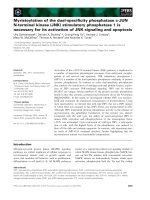

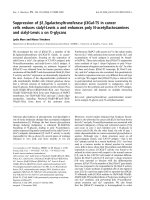
![Tài liệu Báo cáo khoa học: Expression of two [Fe]-hydrogenases in Chlamydomonas reinhardtii under anaerobic conditions doc](https://media.store123doc.com/images/document/14/br/hw/medium_hwm1392870031.jpg)
